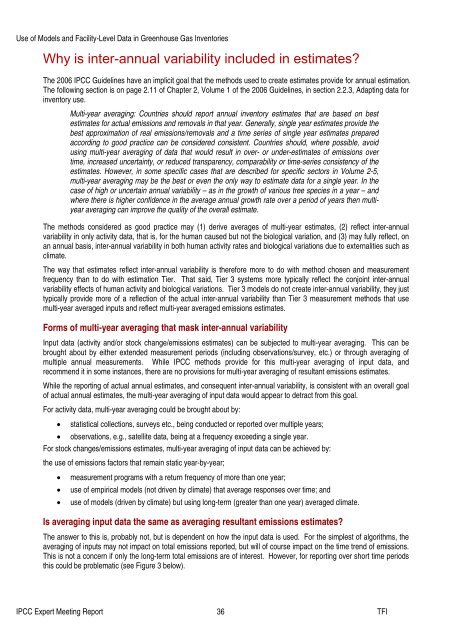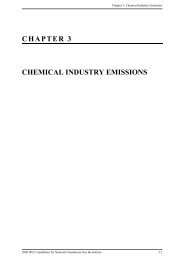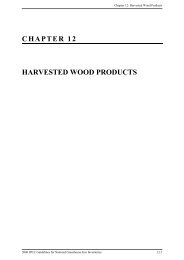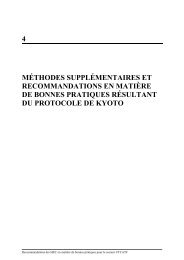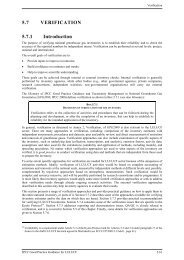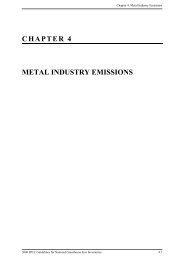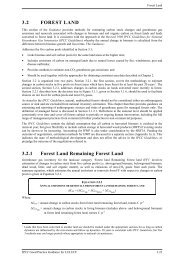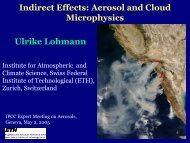Use of Models and Facility-Level Data in Greenhouse Gas Inventories
Use of Models and Facility-Level Data in Greenhouse Gas Inventories
Use of Models and Facility-Level Data in Greenhouse Gas Inventories
You also want an ePaper? Increase the reach of your titles
YUMPU automatically turns print PDFs into web optimized ePapers that Google loves.
<strong>Use</strong> <strong>of</strong> <strong>Models</strong> <strong>and</strong> <strong>Facility</strong>-<strong>Level</strong> <strong>Data</strong> <strong>in</strong> <strong>Greenhouse</strong> <strong>Gas</strong> <strong>Inventories</strong><br />
Why is <strong>in</strong>ter-annual variability <strong>in</strong>cluded <strong>in</strong> estimates?<br />
The 2006 IPCC Guidel<strong>in</strong>es have an implicit goal that the methods used to create estimates provide for annual estimation.<br />
The follow<strong>in</strong>g section is on page 2.11 <strong>of</strong> Chapter 2, Volume 1 <strong>of</strong> the 2006 Guidel<strong>in</strong>es, <strong>in</strong> section 2.2.3, Adapt<strong>in</strong>g data for<br />
<strong>in</strong>ventory use.<br />
Multi-year averag<strong>in</strong>g: Countries should report annual <strong>in</strong>ventory estimates that are based on best<br />
estimates for actual emissions <strong>and</strong> removals <strong>in</strong> that year. Generally, s<strong>in</strong>gle year estimates provide the<br />
best approximation <strong>of</strong> real emissions/removals <strong>and</strong> a time series <strong>of</strong> s<strong>in</strong>gle year estimates prepared<br />
accord<strong>in</strong>g to good practice can be considered consistent. Countries should, where possible, avoid<br />
us<strong>in</strong>g multi-year averag<strong>in</strong>g <strong>of</strong> data that would result <strong>in</strong> over- or under-estimates <strong>of</strong> emissions over<br />
time, <strong>in</strong>creased uncerta<strong>in</strong>ty, or reduced transparency, comparability or time-series consistency <strong>of</strong> the<br />
estimates. However, <strong>in</strong> some specific cases that are described for specific sectors <strong>in</strong> Volume 2-5,<br />
multi-year averag<strong>in</strong>g may be the best or even the only way to estimate data for a s<strong>in</strong>gle year. In the<br />
case <strong>of</strong> high or uncerta<strong>in</strong> annual variability – as <strong>in</strong> the growth <strong>of</strong> various tree species <strong>in</strong> a year – <strong>and</strong><br />
where there is higher confidence <strong>in</strong> the average annual growth rate over a period <strong>of</strong> years then multiyear<br />
averag<strong>in</strong>g can improve the quality <strong>of</strong> the overall estimate.<br />
The methods considered as good practice may (1) derive averages <strong>of</strong> multi-year estimates, (2) reflect <strong>in</strong>ter-annual<br />
variability <strong>in</strong> only activity data, that is, for the human caused but not the biological variation, <strong>and</strong> (3) may fully reflect, on<br />
an annual basis, <strong>in</strong>ter-annual variability <strong>in</strong> both human activity rates <strong>and</strong> biological variations due to externalities such as<br />
climate.<br />
The way that estimates reflect <strong>in</strong>ter-annual variability is therefore more to do with method chosen <strong>and</strong> measurement<br />
frequency than to do with estimation Tier. That said, Tier 3 systems more typically reflect the conjo<strong>in</strong>t <strong>in</strong>ter-annual<br />
variability effects <strong>of</strong> human activity <strong>and</strong> biological variations. Tier 3 models do not create <strong>in</strong>ter-annual variability, they just<br />
typically provide more <strong>of</strong> a reflection <strong>of</strong> the actual <strong>in</strong>ter-annual variability than Tier 3 measurement methods that use<br />
multi-year averaged <strong>in</strong>puts <strong>and</strong> reflect multi-year averaged emissions estimates.<br />
Forms <strong>of</strong> multi-year averag<strong>in</strong>g that mask <strong>in</strong>ter-annual variability<br />
Input data (activity <strong>and</strong>/or stock change/emissions estimates) can be subjected to multi-year averag<strong>in</strong>g. This can be<br />
brought about by either extended measurement periods (<strong>in</strong>clud<strong>in</strong>g observations/survey, etc.) or through averag<strong>in</strong>g <strong>of</strong><br />
multiple annual measurements. While IPCC methods provide for this multi-year averag<strong>in</strong>g <strong>of</strong> <strong>in</strong>put data, <strong>and</strong><br />
recommend it <strong>in</strong> some <strong>in</strong>stances, there are no provisions for multi-year averag<strong>in</strong>g <strong>of</strong> resultant emissions estimates.<br />
While the report<strong>in</strong>g <strong>of</strong> actual annual estimates, <strong>and</strong> consequent <strong>in</strong>ter-annual variability, is consistent with an overall goal<br />
<strong>of</strong> actual annual estimates, the multi-year averag<strong>in</strong>g <strong>of</strong> <strong>in</strong>put data would appear to detract from this goal.<br />
For activity data, multi-year averag<strong>in</strong>g could be brought about by:<br />
• statistical collections, surveys etc., be<strong>in</strong>g conducted or reported over multiple years;<br />
• observations, e.g., satellite data, be<strong>in</strong>g at a frequency exceed<strong>in</strong>g a s<strong>in</strong>gle year.<br />
For stock changes/emissions estimates, multi-year averag<strong>in</strong>g <strong>of</strong> <strong>in</strong>put data can be achieved by:<br />
the use <strong>of</strong> emissions factors that rema<strong>in</strong> static year-by-year;<br />
• measurement programs with a return frequency <strong>of</strong> more than one year;<br />
• use <strong>of</strong> empirical models (not driven by climate) that average responses over time; <strong>and</strong><br />
• use <strong>of</strong> models (driven by climate) but us<strong>in</strong>g long-term (greater than one year) averaged climate.<br />
Is averag<strong>in</strong>g <strong>in</strong>put data the same as averag<strong>in</strong>g resultant emissions estimates?<br />
The answer to this is, probably not, but is dependent on how the <strong>in</strong>put data is used. For the simplest <strong>of</strong> algorithms, the<br />
averag<strong>in</strong>g <strong>of</strong> <strong>in</strong>puts may not impact on total emissions reported, but will <strong>of</strong> course impact on the time trend <strong>of</strong> emissions.<br />
This is not a concern if only the long-term total emissions are <strong>of</strong> <strong>in</strong>terest. However, for report<strong>in</strong>g over short time periods<br />
this could be problematic (see Figure 3 below).<br />
IPCC Expert Meet<strong>in</strong>g Report 36 TFI


